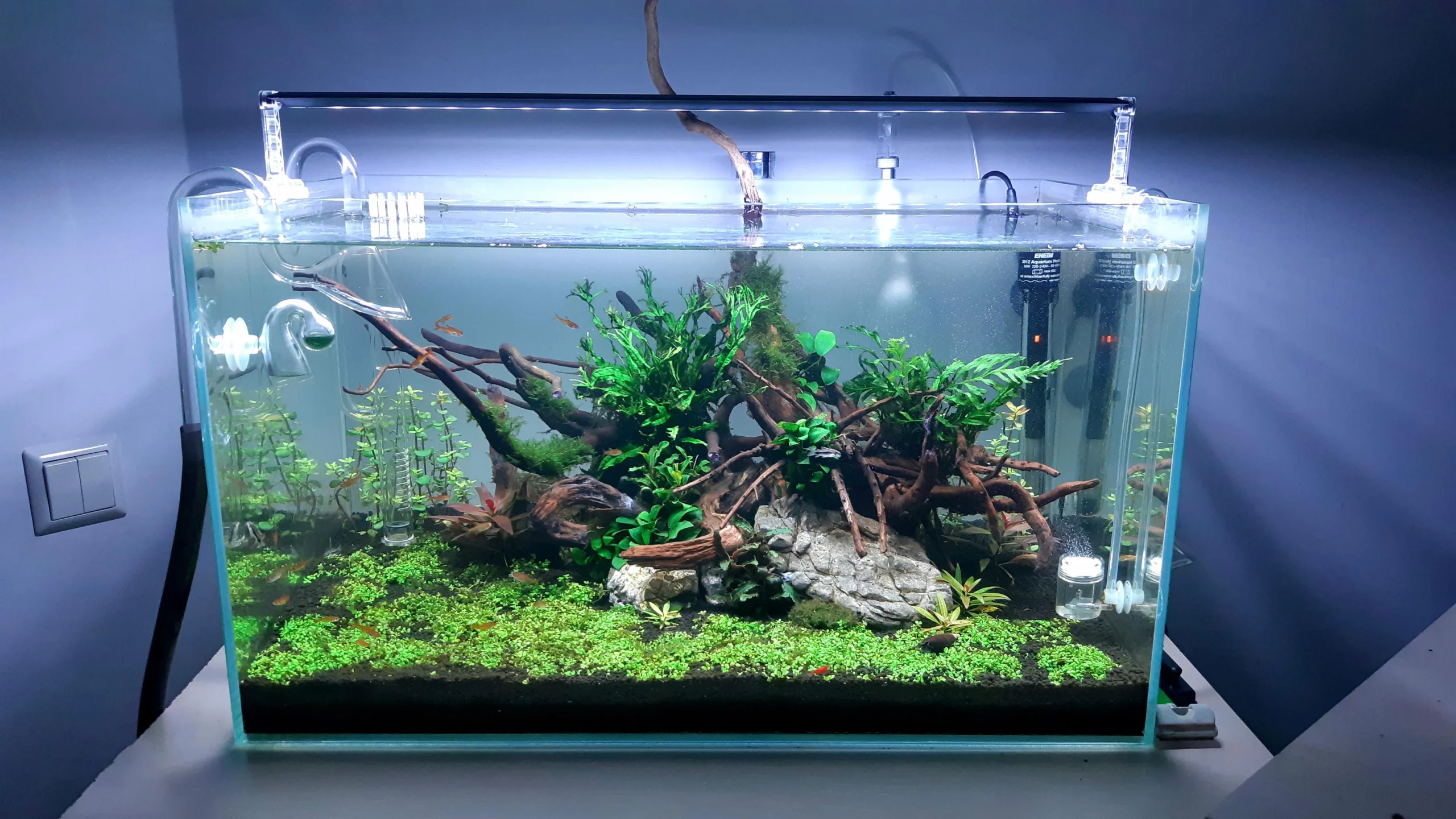
Welcome to the fascinating world of aquariums! Whether you’re a seasoned aquarist or just starting to explore the joys of fishkeeping, there’s always something new to discover beneath the surface. Aquariums are not only beautiful additions to our homes and public spaces, but they also serve as vital ecosystems that house a diverse array of aquatic life. From the intricacies of maintaining a community tank to the educational benefits these underwater habitats provide, aquariums offer a wealth of knowledge and enjoyment. In this blog post, we’ll dive deep into 25 intriguing facts about aquariums that will enhance your appreciation for these aquatic environments. Get ready to explore the wonders of the underwater world and learn something new along the way!
Definition: An aquarium is a transparent container designed to house aquatic organisms, including fish, plants, and invertebrates. The primary purpose of an aquarium is to create a controlled environment that mimics natural aquatic ecosystems, allowing for the observation and care of various species. Aquariums can be made from glass or acrylic and come in various shapes and sizes, from small bowls to large tanks that can hold thousands of gallons. The design and setup of an aquarium can significantly influence the health and well-being of its inhabitants.
First Aquarium: The first modern aquarium was established in 1853 in London, England, by Philip Henry Gosse, a naturalist and aquarist. He created a glass tank filled with water and aquatic plants, which allowed for the observation of marine life in a controlled setting. This innovation sparked interest in keeping fish and other aquatic organisms in home settings, leading to the development of the aquarium hobby. Gosse’s work laid the groundwork for modern aquarium design and maintenance, emphasizing the importance of creating a suitable environment for aquatic life.
Types of Aquariums: Aquariums can be categorized into three main types: freshwater, saltwater, and brackish water aquariums. Freshwater aquariums are the most common and are typically easier to maintain, housing species like goldfish and guppies. Saltwater aquariums, which contain marine organisms, require more specialized equipment and knowledge due to the complexities of maintaining salinity and water chemistry. Brackish water aquariums are a mix of fresh and saltwater, housing species that thrive in estuarine environments, such as certain types of pufferfish and gobies. Each type of aquarium has unique requirements and challenges.
Size Variations: Aquariums come in a wide range of sizes, from small desktop tanks of just a few gallons to massive public aquariums that can hold millions of gallons. Smaller aquariums, such as 5-gallon tanks, are popular for beginners and can house a few small fish or invertebrates. In contrast, large aquariums, like the 1.5 million-gallon tank at the Georgia Aquarium, house a diverse array of marine life, including sharks and rays. The size of the aquarium influences the types of species that can be kept, the complexity of the ecosystem, and the level of maintenance required.
Filtration: Most aquariums require a filtration system to maintain water quality and remove toxins. Filtration is critical for the health of aquatic organisms, as it helps to remove waste products, uneaten food, and harmful chemicals from the water. There are three main types of filtration: mechanical, biological, and chemical. Mechanical filtration removes physical debris from the water, biological filtration utilizes beneficial bacteria to break down harmful ammonia and nitrites, and chemical filtration removes impurities through substances like activated carbon. A well-functioning filtration system is essential for creating a stable and healthy environment for fish and plants.
Aquascaping: The art of arranging aquatic plants, stones, and other elements in an aquarium is known as aquascaping. This practice combines creativity and horticulture, allowing hobbyists to create visually stunning underwater landscapes. Aquascaping involves selecting compatible plants and hardscape materials, such as rocks and driftwood, to create a balanced and aesthetically pleasing design. Successful aquascaping takes into account the growth habits of plants, the needs of the fish, and the overall ecosystem dynamics. Competitions and exhibitions often showcase exceptional aquascaping designs, inspiring enthusiasts to push the boundaries of their creativity.
Photosynthesis: Aquarium plants perform photosynthesis, a process that converts light energy into chemical energy, producing oxygen and improving water quality. During photosynthesis, plants absorb carbon dioxide and release oxygen, which is essential for the survival of fish and other aerobic organisms. The presence of healthy plants in an aquarium not only enhances the aesthetic appeal but also contributes to the overall health of the ecosystem by stabilizing pH levels and providing hiding spaces for fish. Proper lighting, usually in the form of LED or fluorescent bulbs, is crucial for promoting healthy plant growth and maximizing photosynthesis.
Cycle: The nitrogen cycle is crucial in aquariums; it involves the conversion of ammonia to nitrites and then to nitrates. When fish excrete waste or uneaten food decomposes, ammonia levels rise, which can be toxic to aquatic life. Beneficial bacteria in the aquarium substrate and filter convert ammonia into nitrites, which are also harmful but are then further converted into nitrates by another group of bacteria. Nitrates are less toxic and can be managed through regular water changes or by using live plants that absorb them as nutrients. Establishing a stable nitrogen cycle is vital for maintaining a healthy aquarium environment.
Temperature Control: Most tropical fish thrive in water temperatures between 75°F and 80°F (24°C to 27°C). Maintaining the appropriate temperature is essential for the health and well-being of aquarium inhabitants, as it affects their metabolism, behavior, and overall vitality. Temperature fluctuations can stress fish and make them more susceptible to diseases. Many aquariums are equipped with heaters to regulate water temperature, especially in colder climates. It is also important to use a reliable thermometer to monitor the water temperature regularly, ensuring that it remains within the optimal range for the specific species being kept.
Lighting: Proper lighting is essential for plant growth and fish health in an aquarium. Lighting can influence the behavior and well-being of aquatic organisms, as well as the aesthetic appeal of the tank. Most aquariums utilize LED lights or fluorescent bulbs, which provide the necessary spectrum for photosynthesis while being energy-efficient. The duration and intensity of light exposure should be carefully managed; typically, aquariums benefit from 8 to 12 hours of light per day. This not only supports the growth of aquatic plants but also helps to maintain a natural day-night cycle for the fish, contributing to their overall health and reducing stress.
Saltwater vs. Freshwater: Saltwater aquariums generally require more maintenance and are more expensive than freshwater ones. This is primarily due to the complexity of maintaining the appropriate salinity and water chemistry needed for marine life. Saltwater fish and invertebrates often have specific habitat requirements, and the introduction of live rock and coral can create a more intricate ecosystem. Additionally, saltwater aquariums typically necessitate more advanced filtration systems, protein skimmers, and regular monitoring of parameters like pH, salinity, and ammonia levels. While they can be more challenging to maintain, saltwater aquariums offer the opportunity to keep a wider variety of colorful and exotic species.
Biomes: Aquariums can replicate various aquatic biomes, including coral reefs, rivers, and lakes. Each biome has its unique characteristics, influencing the types of species that can thrive within it. For example, a coral reef aquarium mimics the vibrant and diverse ecosystem found in tropical oceans, requiring specific lighting and water conditions to support corals and reef fish. In contrast, a river aquarium might feature flowing water, substrate materials like gravel or sand, and species that prefer a current, such as certain tetras or barbs. Understanding the specific needs of different biomes helps aquarists create balanced environments that support the health and well-being of their aquatic inhabitants.
Fish Species: There are over 30,000 species of fish, many of which can be kept in aquariums. This incredible diversity allows hobbyists to create unique and varied displays, showcasing different colors, shapes, and behaviors. Popular freshwater species include bettas, guppies, and angelfish, while saltwater enthusiasts may choose clownfish, tangs, and wrasses. When selecting fish, it is crucial to consider their compatibility, size, and environmental needs to ensure a harmonious aquarium community. The vast array of available species offers endless possibilities for customization and creativity in aquarium design.
Marine Life: Popular marine species for saltwater aquariums include clownfish, tangs, and angelfish. Clownfish, known for their vibrant orange coloration and symbiotic relationship with anemones, are a favorite among beginners due to their hardiness and ease of care. Tangs, such as the blue tang, are known for their striking colors and active swimming behavior, making them a popular choice for larger tanks. Angelfish, with their unique shapes and patterns, add visual interest to any marine setup. However, it’s essential to research each species’ specific care requirements, including tank size, diet, and social behavior, to ensure a successful and thriving aquarium.
Freshwater Species: Popular freshwater species include bettas, guppies, and tetras. Bettas, also known as Siamese fighting fish, are well-loved for their stunning fin displays and vibrant colors. They are relatively easy to care for but require specific tank conditions to prevent stress and aggression. Guppies are small, colorful fish that breed readily in aquariums, making them a favorite for community tanks. Tetras, such as neon and cardinal tetras, are schooling fish that thrive in groups, adding movement and color to the aquarium. Each of these species brings unique characteristics and behaviors that contribute to the overall dynamics of a freshwater setup.
Aquarium Maintenance: Regular maintenance includes water changes, cleaning filters, and monitoring water parameters. Performing routine water changes, typically 10-15% weekly, helps to remove accumulated waste and toxins while replenishing essential minerals. Cleaning filters is vital to ensure they function effectively, as clogged filters can lead to poor water quality. Additionally, monitoring water parameters such as pH, ammonia, nitrite, and nitrate levels is crucial for maintaining a stable environment. Keeping a maintenance schedule helps prevent issues and ensures a healthy ecosystem for fish and plants.
Aquarium Cycling: New aquariums typically need to be cycled for several weeks to establish beneficial bacteria. The cycling process allows for the development of a stable nitrogen cycle, where beneficial bacteria convert harmful ammonia from fish waste into less toxic nitrates. This process can take anywhere from 4 to 6 weeks, and it’s essential to monitor water parameters during this time to ensure the environment is safe for fish. There are different methods for cycling an aquarium, including fishless cycling, which uses ammonia to promote bacterial growth, or cycling with hardy fish species. Proper cycling is critical to prevent fish stress and mortality.
Community Tanks: Community tanks are designed to accommodate multiple species of fish that can coexist peacefully. The success of a community tank relies heavily on selecting compatible species that share similar water conditions, temperaments, and dietary needs. For example, smaller, peaceful fish like tetras can thrive alongside other non-aggressive species, while larger or more territorial fish, such as cichlids, may disrupt the harmony. Proper planning and research are crucial to ensure that all inhabitants can flourish without causing stress or aggression towards one another.
Tank Mates: When setting up a community aquarium, it is essential to research and select compatible tank mates to avoid aggression and stress among the fish. Different species have varying temperaments; some are more territorial or aggressive than others. For instance, while guppies are generally peaceful, species like bettas can be highly aggressive towards their own kind and other fish with similar fin shapes. Understanding the social dynamics of the species involved, including their size, behavior, and environmental needs, is key to maintaining a healthy and balanced aquarium ecosystem.
Aquarium Decor: The decor in an aquarium plays a vital role in creating a suitable habitat for fish. Common decorations include rocks, driftwood, and artificial plants, which not only enhance the visual appeal of the tank but also provide essential hiding spots and territories for fish. These elements help reduce stress by allowing fish to retreat and feel secure, mimicking their natural environment. Additionally, the choice of decor can influence the overall health of the aquarium, as certain materials can affect water chemistry, while live plants can improve water quality by absorbing nitrates and providing oxygen.
Feeding: Fish diets are diverse and vary significantly among species, with some being herbivores, others carnivores, and many classified as omnivores. It is crucial to provide a balanced diet tailored to the specific needs of each species to promote optimal health and growth. For instance, herbivorous fish thrive on a diet rich in plant matter, such as algae and leafy greens, while carnivorous fish require protein sources like insects or other fish. Omnivores, like goldfish, benefit from a mix of both plant and animal-based foods. Understanding these dietary requirements helps prevent malnutrition and ensures the well-being of aquarium inhabitants.
Lifespan: The lifespan of aquarium fish can vary dramatically depending on the species. Some fish, like bettas and guppies, typically live for just a few years, while others, such as goldfish and some cichlids, can live for decades with proper care. For example, a well-cared-for goldfish can live up to 20 years or more, while certain species of cichlids can reach similar ages. Factors such as water quality, diet, tank size, and overall care play significant roles in determining the lifespan of aquarium fish. Knowledge of the specific lifespan of each species helps aquarists plan for the long-term commitment required in fishkeeping.
Public Aquariums: The Georgia Aquarium in Atlanta, USA, is renowned as one of the largest public aquariums in the world, housing thousands of aquatic animals across numerous exhibits. Opened in 2005, it features a diverse array of marine and freshwater species, including whale sharks, beluga whales, and various species of rays. The aquarium plays a critical role in education and conservation, providing visitors with insights into aquatic ecosystems and the importance of preserving marine life. Public aquariums like Georgia’s serve as vital resources for research, conservation efforts, and public engagement with environmental issues.
Aquarium Shows: Competitions for aquascaping and fishkeeping are held worldwide, showcasing the skills and creativity of hobbyists. These events often feature categories for different styles of aquascaping, such as natural, minimalist, or biotope setups, where participants design and maintain visually stunning aquariums that mimic natural habitats. Judges evaluate entries based on criteria like creativity, plant health, and overall aesthetics. Such competitions foster a sense of community among aquarists and encourage knowledge sharing, inspiring others to enhance their own aquarium setups and deepen their understanding of aquatic ecosystems.
Educational Value: Aquariums serve as powerful educational tools, promoting awareness of aquatic ecosystems and the importance of conservation. They provide visitors with the opportunity to learn about various species, their habitats, and the environmental challenges they face. Through interactive exhibits, educational programs, and conservation initiatives, aquariums foster a deeper understanding of biodiversity and the need to protect aquatic environments. They often collaborate with schools and community organizations to raise awareness and inspire future generations to engage in conservation efforts, emphasizing the interconnectedness of all living organisms and the ecosystems they inhabit.
FAQs about Aquariums
1. What size aquarium should I get?
The best aquarium size depends on several factors, including the type and number of fish you want to keep, your budget, and the space you have available. Larger tanks are generally easier to maintain than smaller tanks because they are more stable. Changes in water parameters (temperature, pH, ammonia, etc.) happen more slowly in larger volumes of water, giving you more time to correct any issues.
- Small Tanks (under 10 gallons): These are generally not recommended for beginners. They are very sensitive to changes in water quality and are only suitable for a very limited selection of small fish or invertebrates. Nano tanks can be challenging!
- Medium Tanks (10-55 gallons): This is a good starting range for many beginners. A 20-gallon long or a 29-gallon tank offers a good balance of space and manageability. You can keep a wider variety of fish in this size range.
- Large Tanks (over 55 gallons): These tanks offer the most flexibility and are ideal for keeping larger fish or a larger community of fish. However, they require a larger investment in terms of cost, maintenance, and space.
Key Considerations for Size:
- Fish Size: Research the adult size of the fish you want to keep. Many fish sold as juveniles grow much larger than you might expect. Overcrowding is a major cause of stress and disease in aquariums.
- Swimming Space: Fish need room to swim. Active fish require more space than less active fish.
- Water Volume and Stability: As mentioned earlier, larger tanks are more stable.
- Weight: A filled aquarium is very heavy! Make sure your floor can support the weight. A 10-gallon tank weighs about 100 pounds, and larger tanks can weigh hundreds or even thousands of pounds.
- Maintenance: Larger tanks require more water changes, but the changes are less frequent.
2. What fish are good for beginners?
Good beginner fish are generally hardy, peaceful, and don’t require highly specialized care. Here are a few popular options:
- Guppies: These livebearers are easy to breed and come in a variety of colors.
- Platies: Similar to guppies, platies are also livebearers and come in many colors and patterns.
- Mollies: Another livebearer that is relatively easy to care for. Mollies prefer slightly harder water.
- Swordtails: Related to guppies, platies, and mollies, swordtails are known for their distinctive sword-like tail.
- Neon Tetras: These small, brightly colored fish are a popular choice for community tanks. They prefer to be kept in schools of at least six.
- Zebra Danios: These active fish are very hardy and can tolerate a wide range of water conditions.
- Betta Fish (Siamese Fighting Fish): While bettas are relatively easy to care for, they require specific care. They are solitary fish and should not be kept with other bettas (males will fight). They can sometimes be housed with peaceful community fish, but this should be done with caution.
- Corydoras Catfish: These small, bottom-dwelling catfish are peaceful and help keep the tank clean by eating leftover food.
Important Note: Even “beginner fish” require proper care. Research the specific needs of any fish you are considering before you purchase them.
3. How do I set up a new aquarium?
Setting up an aquarium involves several key steps:
- Planning: Decide on the size of the tank, the type of fish you want to keep, and where you will place the tank.
- Gathering Supplies: You’ll need the tank itself, a filter, a heater (if needed), a light, substrate (gravel or sand), decorations, water conditioner, a test kit, and a net.
- Preparing the Tank: Rinse the tank and substrate. Place the substrate in the tank. Add decorations.
- Filling the Tank: Fill the tank with dechlorinated water. Use a water conditioner to remove chlorine and chloramine from tap water.
- Setting up the Filter and Heater: Install the filter and heater according to the manufacturer’s instructions.
- Cycling the Tank: This is the most crucial step. Cycling establishes the beneficial bacteria that break down harmful waste products in the aquarium. This process can take several weeks. You can use a commercial bacteria starter to speed up the process. Test your water regularly during cycling.
- Adding Fish: Once the tank is cycled, you can start adding fish, but do so gradually. Don’t add too many fish at once.
4. How do I cycle my aquarium?
Cycling an aquarium is the process of establishing a biological filter. This filter consists of beneficial bacteria that convert harmful ammonia and nitrite into less harmful nitrate. Here’s a simplified explanation:
- Ammonia Source: You need to introduce ammonia into the tank. This can be done by adding a small amount of fish food or using pure ammonia.
- Bacteria Growth: Ammonia-eating bacteria will start to grow. These bacteria convert ammonia into nitrite.
- Nitrite-Eating Bacteria: Nitrite-eating bacteria will then grow and convert nitrite into nitrate.
- Testing: Use a test kit to monitor the levels of ammonia, nitrite, and nitrate. During cycling, ammonia and nitrite levels will spike and then gradually decline to zero. Nitrate levels will start to rise.
- Water Changes: Perform small water changes during cycling to prevent ammonia and nitrite levels from getting too high.
- Cycling Complete: The tank is cycled when ammonia and nitrite levels consistently read zero, and you have measurable nitrate levels.
5. How often should I clean my aquarium?
Regular maintenance is essential for a healthy aquarium. Here’s a general guideline:
- Weekly: Perform a partial water change (20-25%). Gravel vacuum the substrate to remove debris. Clean the inside glass.
- Monthly: Clean the filter media (but don’t replace it unless it’s damaged). Test your water parameters.
- As Needed: Trim plants, clean decorations, and address any other issues that arise.
6. What do I feed my fish?
The best food for your fish depends on the species. Research the dietary requirements of your fish. Most fish will thrive on a diet of high-quality flake food, supplemented with frozen or live foods. Feed your fish small amounts of food that they can consume in a few minutes. Overfeeding is a common problem that can lead to poor water quality.
7. How do I know if my fish are sick?
Sick fish may exhibit a variety of symptoms, including:
- Loss of appetite
- Lethargy
- Clamped fins
- Changes in color
- White spots or other growths
- Difficulty breathing
- Swimming erratically
If you suspect your fish are sick, research the specific symptoms and treat accordingly. Quarantine sick fish in a separate tank to prevent the spread of disease.
8. What are some common aquarium problems?
- Algae: Algae growth is a common problem. It can be controlled by regular water changes, proper lighting, and the addition of algae-eating fish or invertebrates.
- Cloudy Water: Cloudy water can be caused by a bacterial bloom, poor water quality, or other factors.
- Ich (White Spot Disease): Ich is a parasitic disease that causes white spots on the fish’s body.
- Ammonia or Nitrite Spike: High levels of ammonia or nitrite can be toxic to fish. This is often caused by overfeeding, overcrowding, or a problem with the biological filter.
This is just a starting point. There’s a lot to learn about aquariums, but hopefully, these FAQs have provided a good foundation. Remember to always research the specific needs of the fish you want to keep and be prepared to dedicate time and effort to maintaining your aquarium. Good luck!









